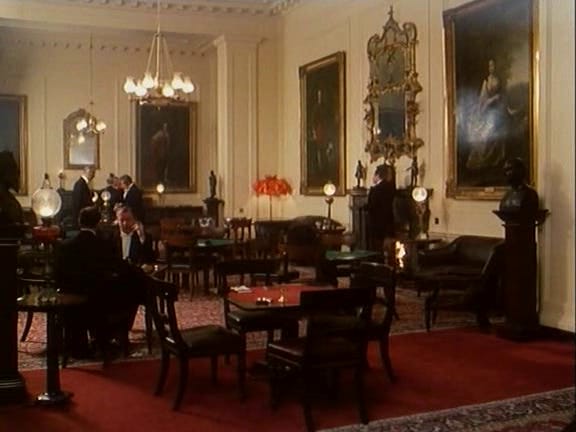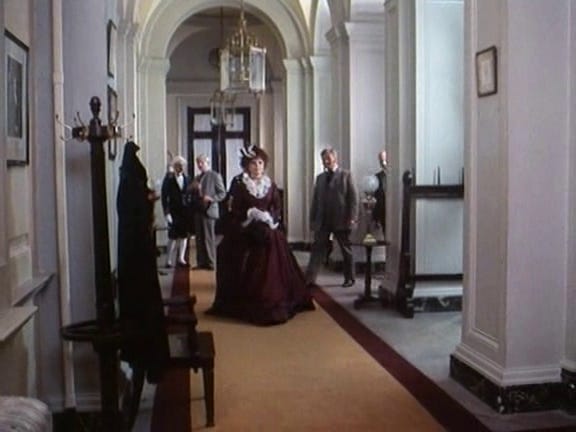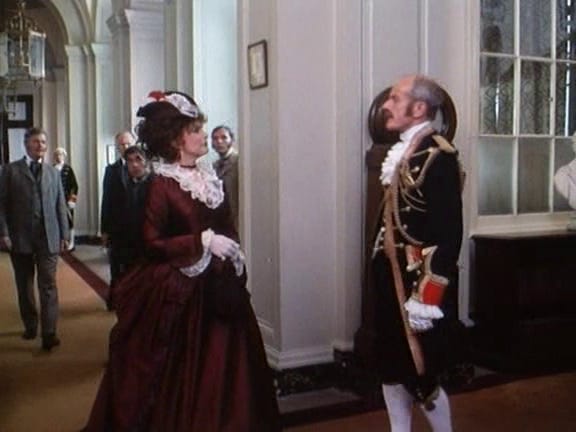Around the World in 80 Days, Part 4 - the 1989 mini-series
This is Around the World in 80 Days week. That’s right, with its depiction of the Reform Club being so iconic, I’m going to do a separate post for 6 days this week, each one looking at a different version of Around the World in 80 Days, and how it depicts the Reform Club.
Today, I am looking at the 1989 three-part mini-series, starring Pierce Brosnan as Fogg, Eric Idle as Passepartout, Julia Nickson as Aouda, and Peter Ustinov as Fix. This has taken a lot of flak over the years for its considerable deviations from the novel (especially compared to the much more faithful 1956 film); but I remain rather fond of it - especially as some of the changes tie in to real-life events, such as the Siege of Paris during the Franco-Prussian War, which is skipped over in Verne’s novel, written (and set) just one year later.
And this is why I like the mini-series so much: it is not a bad screen rendition of life in 1871. This extends to its depiction of club life.
The exterior used for the Reform Club barely resembles the real thing, beyond being an early 19th century building. In some ways, this is quite understandable, given the traffic congestion along Pall Mall, and the logistics of filming a period drama there. What doubled for the Reform Club’s exterior as observers huddled outside was in fact the Stone Buildings of Lincoln’s Inn, parallel to Chancery Lane. Its location allowed filming without any traffic.
The interior is not of the Reform Club, either. But it is of the next-best thing: the Travellers Club, next door on Pall Mall.
Though rendered in a different architectural style, modelled on an English country house, the Travellers Club has one great advantage in portraying the Reform Club: it was built by the same architect, Charles Barry, less than a decade earlier. Moreover, it was a fully functioning London clubhouse filled with period furniture, and so it affords a level of authenticity not previously seen in screen adaptations of the novel.
Remember that it was not until the 1950s and 1960s that London clubs began to admit film cameras into their interiors, so this 1989 mini-series is still a relatively early glimpse inside Clubland.
And Barry’s Travellers Club building is a fascnating architectural halfway-house: the “missing link” between the small, pokey aristocratic townhouses of Georgian clubs in the English country house style (i.e. White’s, Brooks’s, Boodle’s, Arthur’s - now the Carlton), and the increasingly vast and palatial mansions of 19th century clubs which would dot Pall Mall (i.e. the United Service Club, the Athenæum, the Reform Club, the Oxford & Cambridge Club, and later the RAC).
Indeed, it is sometimes hard to believe that the Travellers Club building was the work of the same architect as the Reform Club. For instance, the use of space is very different: Whereas the Reform is built around a large central saloon for members to wander around and look down upon from the gallery above, the Travellers is built around a central lightwell not normally accessible to members.
Yet this mini-series also makes abundant use of the stock architectural features of a bona fide clubhouse - like the grand stairwell. Again, note how the Travellers Club staircase (left) captures the architectural transformation between the subdued staircase of an 18th century club like Brooks’s (centre), and the sheer opulence of the later Reform Club staircase (right).
The fixtures, fittings and paintings are of course all authentic clubland artworks - no tat from a studio prop department, as in the set used for the 1956 film.
The furniture is all thoroughly authentic, too, although there is admittedly some rearrangement of that furniture - for instance, card tables aren’t usually laid out in the Morning Room like this.
There is also some misleading photography around the internal confiuguration: the last episode’s dramatic dash against time to reach the Club’s card room shows a frantic run upstairs to reach the room, suggesting it is on the first floor, when the scenes here were actually filmed in the Travellers Club’s Outer Morning Room on the ground floor.
Even the timepieces are real pieces of working club furniture that can still be found ticking along today.
And even the makeshift bits of furniture moved in for displaying the bookies' odds on Fogg's journey have the look of authenticity about them.
One touch I particularly appreciated, next to Christopher Lee here: an original 19th century ballot box, for anonymously voting for new members, with white balls for ‘yes’, and black balls for ‘no.’ This was. of course, the etymological root of the notion of “blackballing.” (Lee himself was a keen club member, belonging to Buck’s.)
And the costumes are spot-on in the club scenes, too. They did not simply go for generic, standardised white-tie-and-tails, as you'd see in so many Hollywood epics; they went for a peculiarly 1870s form of White Tie, before it was regularised. The collars and shirt fronts were stiffer, and the bow ties were much more individual, offering more choice for dandified touches beetween the characters.
The club servants’ ornate livery was pretty accurate for the period, too, emulating 18th century court dress that was still used by club servants until the late 19th century.
Meanwhile, the Coffee Room scenes (left) now serve as something of a time capsule, because the Club underwent serious restoration shortly after filming, stripping away the paint to rediscover its original, paler mustard colour scheme by Charles Barry (right) - so the mini-series shows what the Travellers Club was like for most of the 1980s. This also allows us to date principal photography on the series, since the Coffee Room restoration happened in 1988, and so filming must have occurred just before then. The room’s previous colour scheme was the result of a post-war redecoration overseen by former Club Secretary Robin McDouall.
Conclusion
As a whole, the 1989 mini-series may take considerable liberties with the plot; and the Travellers’ clubhouse from 1826-7 is almost a throwback to the Regency era, compared to the pseudo-Italianate architecture of Barry's 1838-41 Reform clubhouse next door.
Nonetheless, it works - and it looks authentic. There is a wonderful eye for detail in how the club interiors are filmed, from wardrobe to furniture, and it is an entirely consistent depiction of club life. (Even if they repeat the 1956 film’s bit of business about there being general astonishment at women in a club, when - as I’ve said before - this was far from unusual in the Reform Club of the 1870s.)
(This piece was adapted from an old Twitter thread I wrote on the topic three years ago. This is Part 4 of my 6-part look at six different versions of ‘Around the World in 80 Days’; previous articles have looked at Jules Verne’s original novel; the 1956 film adaptation; and at the cartoon adaptations.)
You can view the full and varied backlog of Clubland Substack articles, by clicking on the index below.
Index
Articles are centred around several distinct strands, so the below contains links to the main pieces, sorted by theme.

















